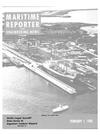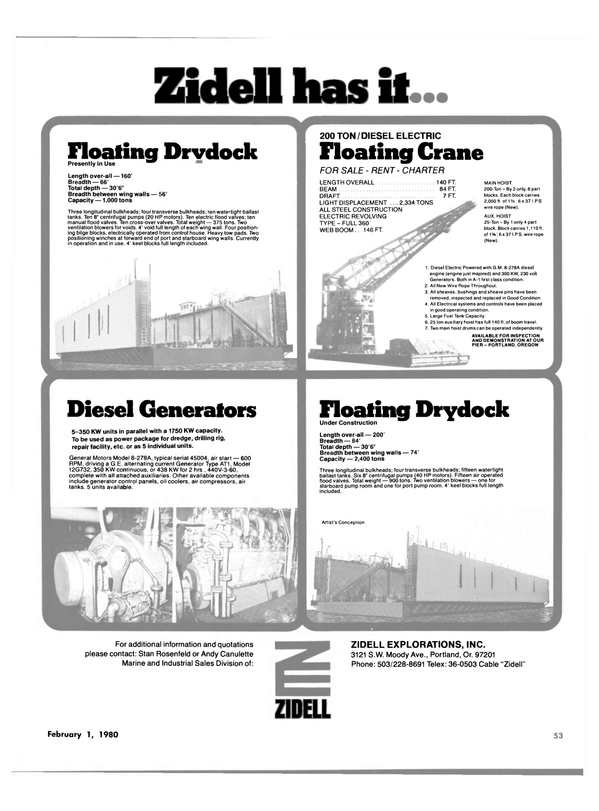
Key Promotions At Lockheed Shipbuilding
The past five years in the history of Lockheed Shipbuilding and Construction Company, Seattle, Wash., have been marked by construction of three new submarine tenders for the U.S. Navy and expansion of ship repair capabilities.
Concurrent with construction of AS-39 Land-class submarine t e n d e r s , Lockheed Shipbuilding has pursued and captured "lead-in" contracts for a new class of Landing Ship Docks (LSD-41). It is anticipated that construction start of the LSD-41 "Lead Ship" will overlap delivery of the third submarine tender (AS-41) in 1981. Lockheed's shipyard expects to build LSD-41 and following ships of this class well into the 1980s Through the 70s, Lockheed Shipbuilding's marketing activities were directed primarily by the president's office. Marketing plans for the 80s will require more attention and have prompted the promotion of John N.
Watt to a newly established position—director of marketing. Mr. Watt has been program manager of the successful submarine tender program.
Mr. Watt received a B.S. degree in engineering from the University of Portland, Portland, Ore., following active duty. He continued graduate studies in naval architecture at the University of Washington, Seattle.
In 1952, he joined the Puget Sound Naval Shipyard as a naval architect. At PSNS in 1954, he directed engineering and installation of the first canted deck on a U.S. Navy aircraft carrier.
Leaving PSNS in 1955, he developed shipboard and submarine fleet ballistic missile support systems for Chrysler Missile Corporation in Detroit, Mich., until moving to Aerojet General in Sacramento, Calif, in 1957.
He held key program and engineering assignments during Aerojet's work on the propulsion system for Polaris missiles. He later was involved in engineering studies of surface effect ships, air cushion vehicles, and amphibious assault craft. He held positions of increasing responsibility, beginning in 1969 in Aerojet General's 100-ton Surface Effect Ship Program through delivery and tests of the craft, serving as deputy program manager in Tacoma, Wash., until joining Lockheed in 1974.
Mr. Watt is a past national secretary of the Society of Aerospace Materials and Process Engineers, and a member of the American Society of Naval Engineers.
A long-time company veteran in manager and director positions, William A. Woodrow will succeed Mr. Watt as submarine tender program manager.
Mr. Woodrow joined Lockheed Shipbuilding and Construction Company in 1956 as a buyer. He progressed through positions of increasing responsibility as director of purchasing and material control, industrial engineering, management control and scheduling, contract administration, production planning and director of new program development.
Following World War II, Mr. Woodrow joined the Westinghouse Electric Corporation in Seattle. In 1950, he joined the Puget Sound Naval Shipyard, and in 1953 he transferred to the supervisor of shipbuilding office, Seattle, as a Naval Progressman.
Named Civilian Assistant to the Resident Supervisor of Shipbuilding, he assisted in establishing the first Resident's office at the shipyard, then Puget Sound Bridge and Dredging Company.
As LSCC's director of new program development, he has headed the teams responding to the Navy's Request for Proposal for the LSD-41 (Landing Ship Dock), T-ARC-7 (Cable Repair Ship) and the proposal for overhaul and repair of the USS Sacramento, AOE-1.
Read Key Promotions At Lockheed Shipbuilding in Pdf, Flash or Html5 edition of February 1980 Maritime Reporter
Other stories from February 1980 issue
Content
- Four 600-HP Pusher Tugs Completed By Valmet page: 6
- H.J. Ruehsen Of Bethlehem Steel Addresses SNAME Chesapeake Section page: 6
- Shipbuilders Council Reports U.S. Shipbuilding Produces Net Plus Economic Effect page: 6
- Riverway Shipyard Delivers 50' Towboat To Corps Of Engineers page: 6
- Two Japanese Firms Renew License Agreements With B&W Engineering page: 8
- Robert Sanders To Yard Superintendent page: 8
- Andino Appointed VP At Crowley Maritime International Division page: 11
- New Literature Offered On Gems Level Switch For Corrosive Media Use page: 11
- Phillip Gresser Associates Will Move Offices To Palm Beach, Florida page: 11
- Mangone Building New Special Purpose Tanker For Sun Transport page: 12
- Tandanor, S.A. Installs World's Largest Shiplift page: 12
- Fitzgerald To Head MarAd Title XI Program page: 12
- First Of Two For Waterman -S/S Benjamin Harrison- Christened At Avondale page: 12
- Wiley Completes Ferryboat Surry To Operate At James River Crossing page: 12
- MarAd Appoints Neumann Maritime Aids Deputy page: 14
- NASSCO Delivers 188,500-DWT ARCO Alaska To Arch Tankers page: 14
- Norwegian Order For Cargo Carrier To IHI page: 15
- Acadian Will Build Up To Four Clipper-Class Container Feeder Ships page: 15
- Thompsen Appointed VP At Jackson Engineering page: 15
- National Marine Adds Drydock And Fabrication Shop To Shipyard page: 16
- Wendt Named President Of Sperry Division page: 16
- De Laval Separator To Become Alfa-Laval, Inc. page: 17
- Parsons Brinckerhoff Will Develop Boston Container Terminal page: 17
- Free Bulletin Offered On Marine Alternators For Work, Crew, Supply Boats page: 17
- Superseiner Napoleon-First Of Three- Delivered By Peterson Builders page: 18
- Rossway Named VP Of Twin City Shipyard page: 18
- Sayville Ferry Service Adds New Vessel To Fleet page: 18
- Fink And Calvert Named At Wichita Clutch Co. page: 18
- $120-Million Amoco Jacket Contract Awarded To McDermott Scotland page: 20
- E.J. Murphy Made Senior VP Of Coscol Petroleum And Coscol Marine Corp. page: 20
- Chesapeake Section SNAME Hears Ocean Energy Systems Paper page: 20
- Top Management Changes Announced By Lockheed page: 21
- Millard Named Deputy Managing Director Of Mooremack, South Africa page: 21
- Toronto-U.S. Ferry Service Subject Of MarAd Study page: 22
- Three Appointed To Key Positions At Morris Guralnick Associates page: 22
- M/V National Energy Christened In New Orleans page: 24
- Literature Offered On New Harris RF Communications Synthesized Transceiver page: 24
- Atlantic Marine Delivers 74' Combination Trawler John Gregory page: 24
- Second Winter Trawler Delivered By Valmet page: 27
- Am-Can To Start Tug-Barge Service On Great Lakes In '81 page: 27
- Second Tsavliris Bulkcarrier Delivered By CCN page: 29
- McDermott Develops New Pipeline Welding System —Literature Available page: 29
- Top Executives Promoted At Curtis Bay Towing page: 34
- Free Brochure Available On Saab Microwave Tank Level Gauging System page: 34
- Wayne Musgrove To Head New Chem-Marine Corp. page: 34
- Santa Fe To Install 2 Production Platforms For Union Oil Company page: 36
- Texaco Names Quegan Ass't General Manager Fleet Operations page: 36
- Santa Fe Names Three To Top Management Posts page: 36
- NABRICO Delivers Four Of Six New Barges To Hollywood Marine page: 36
- Decker Named VP And General Manager Of Sperry Gyroscope Unit page: 38
- McGraw-Edison Names R.V. Jeck President Of Worthington Pump Unit page: 39
- Booklet Available From Kaiser Chemicals On Corrosion Protection page: 39
- Bridgestone Receives $5-Million Order For Hose For LOOP Terminal page: 39
- MTU/North America Opens U.S. Corporate Headquarters In Houston page: 39
- Blount Marine Delivers Innovative Cruise Ship New Shoreham II page: 40
- San Marcos Purchases Vessel For Conversion In Japanese Yard page: 40
- Jackson Engineering Names Paul Reynolds Supervisor, Coatings Dept. page: 40
- Three Promoted At J.J. Henry Moorestown Office page: 41
- Swiftships Completes The Streljko For Yugoslavian Owners page: 41
- ASNE So. New England Section Hears Gen'l Dynamics Paper On LNG Spheres page: 41
- Parker Towing Barge And Towboat Project To Cost $14 Million page: 42
- Bird-Johnson Names Gulf Coast Manager page: 42
- Literature Describes Expanded EPSCO Radar Line page: 42
- NOAA Survey Of Remotely Operated Vehicles Available page: 43
- Inter Island Conference Set For March 11-14 In Manila, Philippines page: 46
- New Hose Breakaway Coupling Prevents Spillage —Literature Available page: 46
- Crescent Towing And Salvage Establishes An Alabama Division page: 47
- Galleon Shipping Expands— Adding 9 Multipurpose Ships page: 47
- Conoco Plans Tension Leg Platform For N. Sea Depths To 2,000 Feet page: 47
- J.J. Krebs To Head Board Of Commissioners At Port Of New Orleans page: 47
- Hitachi Delivers Pertamina 1021 To Scorpa Pranedya Navigation page: 48
- Is A Big Bulk Carrier A Good Bet? page: 48
- Halter Awards Contract For $3.5 Million To Gulf Coast Refrigeration page: 49
- Key Promotions At Lockheed Shipbuilding page: 49
- Marathon Delivers Jackup Rig For China page: 50
- Ocean Salvors And Crescent Towing Add Gulf Salvage Station page: 51
- Ten EB Engineers Deliver Papers At Fourth Annual Honors Seminar page: 51
- Aerospace/Marine Technology Compared In New Book Available From SNAME page: 51
- Four VLCC Supertanker Conversions To Include Megasystems Seamatic II page: 52
- Port Of Portland Elects Officers For 1980 page: 52
- RCA Globcom Completes China Marisat Tests page: 52
- Literature Available On Rockwell's New High Pressure/Temp. Valves page: 53


